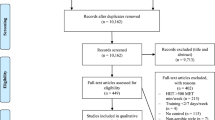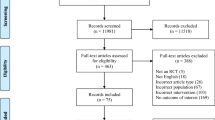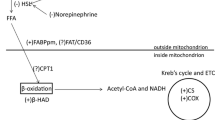Abstract
Background
High-intensity interval training (HIIT) is promoted as a time-efficient strategy to improve body composition.
Objective
The aim of this meta-analysis was to assess the efficacy of HIIT in reducing total, abdominal, and visceral fat mass in normal-weight and overweight/obese adults.
Methods
Electronic databases were searched to identify all related articles on HIIT and fat mass. Stratified analysis was performed using the nature of HIIT (cycling versus running, target intensity), sex and/or body weight, and the methods of measuring body composition. Heterogeneity was also determined
Results
A total of 39 studies involving 617 subjects were included (mean age 38.8 years ± 14.4, 52% females). HIIT significantly reduced total (p = 0.003), abdominal (p = 0.007), and visceral (p = 0.018) fat mass, with no differences between the sexes. A comparison showed that running was more effective than cycling in reducing total and visceral fat mass. High-intensity (above 90% peak heart rate) training was more successful in reducing whole body adiposity, while lower intensities had a greater effect on changes in abdominal and visceral fat mass. Our analysis also indicated that only computed tomography scan or magnetic resonance imaging showed significant abdominal and/or visceral fat-mass loss after HIIT interventions.
Conclusion
HIIT is a time-efficient strategy to decrease fat-mass deposits, including those of abdominal and visceral fat mass. There was some evidence of the greater effectiveness of HIIT running versus cycling, but owing to the wide variety of protocols used and the lack of full details about cycling training, further comparisons need to be made. Large, multicenter, prospective studies are required to establish the best HIIT protocols for reducing fat mass according to subject characteristics.












Similar content being viewed by others
References
Ng M, Fleming T, Robinson M, et al. Global, regional, and national prevalence of overweight and obesity in children and adults during 1980–2013: a systematic analysis for the global burden of disease study 2013. Lancet. 2014;384:766–81.
Obesity: preventing and managing the global epidemic. Report of a WHO consultation. World Health Organ. Tech Rep Ser. 2000;894:i–xii, 1–253.
Wajchenberg BL. Subcutaneous and visceral adipose tissue: their relation to the metabolic syndrome. Endocr Rev. 2000;21:697–738.
Wronska A, Kmiec Z. Structural and biochemical characteristics of various white adipose tissue depots. Acta Physiol Oxf. 2012;205:194–208.
Després J-P, Lemieux I. Abdominal obesity and metabolic syndrome. Nature. 2006;444:881–7.
Johns DJ, Hartmann-Boyce J, Jebb SA, et al. Diet or exercise interventions vs combined behavioral weight management programs: a systematic review and meta-analysis of direct comparisons. J Acad Nutr Diet. 2014;114:1557–68.
Donnelly JE, Blair SN, Jakicic JM, et al. American College of Sports Medicine Position Stand. Appropriate physical activity intervention strategies for weight loss and prevention of weight regain for adults. Med Sci Sports Exerc. 2009;41:459–71.
Lazzer S, Tringali G, Caccavale M, et al. Effects of high-intensity interval training on physical capacities and substrate oxidation rate in obese adolescents. J Endocrinol Investig. 2017;40:217–26.
Maurie J, Brun J, Jean E, et al. Comparaison de deux modalités différentes d’activité physique (SWEET et Lipoxmax) chez des diabétiques de type 2. Sci Sports. 2011;26:92–6.
Shaw K, Gennat H, O’Rourke P, et al. Exercise for overweight or obesity. Cochrane Database Syst Rev. 2006;4:CD003817.
Wu T, Gao X, Chen M, et al. Long-term effectiveness of diet-plus-exercise interventions vs. diet-only interventions for weight loss: a meta-analysis. Obes Rev. 2009;10:313–23.
Boutcher SH. High-intensity intermittent exercise and fat loss. J Obes. 2011;2011:868305.
Keating SE, Johnson NA, Mielke GI, et al. A systematic review and meta-analysis of interval training versus moderate-intensity continuous training on body adiposity. Obes Rev. 2017;18(8):943–64.
Wewege M, Van den berg R, Ward RE, et al. The effects of high-intensity interval training vs. moderate-intensity continuous training on body composition in overweight and obese adults: a systematic review and meta-analysis. Obes Rev. 2017;18:635–46.
Trapp EG, Chisholm DJ, Freund J, et al. The effects of high-intensity intermittent exercise training on fat loss and fasting insulin levels of young women. Int J Obes. 2005;2008(32):684–91.
Maillard F, Rousset S, Pereira B, et al. High-intensity interval training reduces abdominal fat mass in postmenopausal women with type 2 diabetes. Diabetes Metab. 2016;42:433–41.
Weston KS, Wisløff U, Coombes JS. High-intensity interval training in patients with lifestyle-induced cardiometabolic disease: a systematic review and meta-analysis. Br J Sports Med. 2014;48:1227–34.
Azuma K, Matsumoto H. Potential universal application of high-intensity interval training from athletes and sports lovers to patients. Keio J Med. 2017;66:19–24.
Granata C, Oliveira RSF, Little JP, et al. Training intensity modulates changes in PGC-1α and p53 protein content and mitochondrial respiration, but not markers of mitochondrial content in human skeletal muscle. FASEB J. 2016;30:959–70.
MacInnis MJ, Gibala MJ. Physiological adaptations to interval training and the role of exercise intensity. J Physiol. 2017;595:2915–30.
Cohen J. Statistical power analysis for the behavioral sciences. 2nd ed. Hillsdale: Lawrence Erlbaum Associates; 1998.
Gillen JB, Percival ME, Ludzki A, et al. Interval training in the fed or fasted state improves body composition and muscle oxidative capacity in overweight women. Obes Silver Spring. 2013;21:2249–55.
Hutchison SK, Stepto NK, Harrison CL, et al. Effects of exercise on insulin resistance and body composition in overweight and obese women with and without polycystic ovary syndrome. J Clin Endocrinol Metab. 2011;96:E48–56.
Fex A, Leduc-Gaudet J-P, Filion M-E, et al. Effect of elliptical high intensity interval training on metabolic risk factor in pre and type 2 diabetes patients a pilot study. J Phys Act Health. 2015;12:942–6.
Sawyer BJ, Tucker WJ, Bhammar DM, et al. Effects of high-intensity interval training and moderate-intensity continuous training on endothelial function and cardiometabolic risk markers in obese adults. J Appl Physiol. 1985;2016(121):279–88.
Kessler HS, Sisson SB, Short KR. The potential for high-intensity interval training to reduce cardiometabolic disease risk. Sports Med. 2012;42:489–509.
Gibala MJ, Jones AM. Physiological and performance adaptations to high-intensity interval training. Nestle Nutr Inst Workshop Ser. 2013;76:51–60.
Ribeiro RL, de Oliveira Ítalo, Silva J, Dantas M, et al. High-intensity interval training applied in Brazilian Jiu-jitsu is more effective to improve athletic performance and body composition. J Combat Sports Martial Arts. 2015;6:1–5.
Drenowatz C, Hand GA, Sagner M, et al. The prospective association between different types of exercise and body composition. Med Sci Sports Exerc. 2015;47:2535–41.
Verheggen RJHM, Maessen MFH, Green DJ, et al. A systematic review and meta-analysis on the effects of exercise training versus hypocaloric diet: distinct effects on body weight and visceral adipose tissue. Obes Rev. 2016;17:664–90.
Terada T, Friesen A, Chahal BS, et al. Feasibility and preliminary efficacy of high intensity interval training in type 2 diabetes. Diabetes Res Clin Pract. 2013;99:120–9.
Capostagno B, Bosch A. Higher fat oxidation in running than cycling at the same exercise intensities. Int J Sport Nutr Exerc Metab. 2010;20:44–55.
Knechtle B, Müller G, Willmann F, et al. Fat oxidation in men and women endurance athletes in running and cycling. Int J Sports Med. 2004;25:38–44.
Cunha FA, Midgley AW, McNaughton LR, et al. Effect of continuous and intermittent bouts of isocaloric cycling and running exercise on excess postexercise oxygen consumption. J Sci Med Sport. 2016;19:187–92.
Zouhal H, Jacob C, Delamarche P, et al. Catecholamines and the effects of exercise, training and gender. Sports Med. 2008;38:401–23.
Rebuffé-Scrive M, Andersson B, Olbe L, et al. Metabolism of adipose tissue in intraabdominal depots of nonobese men and women. Metabolism. 1989;38:453–8.
Davies CT, Few J, Foster KG, et al. Plasma catecholamine concentration during dynamic exercise involving different muscle groups. Eur J Appl Physiol. 1974;32:195–206.
Nieman DC, Nehlsen-Cannarella SL, Fagoaga OR, et al. Effects of mode and carbohydrate on the granulocyte and monocyte response to intensive, prolonged exercise. J Appl Physiol. 1985;1998(84):1252–9.
Vissers D, Hens W, Taeymans J, et al. The effect of exercise on visceral adipose tissue in overweight adults: a systematic review and meta-analysis. PloS One. 2013;8:e56415.
Morikawa M, Okazaki K, Masuki S, et al. Physical fitness and indices of lifestyle-related diseases before and after interval walking training in middle-aged and older males and females. Br J Sports Med. 2011;45:216–24.
Shuster A, Patlas M, Pinthus JH, et al. The clinical importance of visceral adiposity: a critical review of methods for visceral adipose tissue analysis. Br J Radiol. 2012;85:1–10.
Buchheit M, Laursen PB. High-intensity interval training, solutions to the programming puzzle. Part II: anaerobic energy, neuromuscular load and practical applications. Sports Med. 2013;43:927–54.
Gosselin LE, Kozlowski KF, DeVinney-Boymel L, et al. Metabolic response of different high-intensity aerobic interval exercise protocols. J Strength Cond Res. 2012;26:2866–71.
Bryner RW, Toffle RC, Ullrich IH, et al. The effects of exercise intensity on body composition, weight loss, and dietary composition in women. J Am Coll Nutr. 1997;16:68–73.
Lee M-G, Park K-S, Kim D-U, et al. Effects of high-intensity exercise training on body composition, abdominal fat loss, and cardiorespiratory fitness in middle-aged Korean females. Appl Physiol Nutr Metab. 2012;37:1019–27.
Ahmadizad S, Avansar AS, Ebrahim K, et al. The effects of short-term high-intensity interval training vs. moderate-intensity continuous training on plasma levels of nesfatin-1 and inflammatory markers. Horm Mol Biol Clin Investig. 2015;21:165–73.
Almenning I, Rieber-Mohn A, Lundgren KM, et al. Effects of high intensity interval training and strength training on metabolic, cardiovascular and hormonal outcomes in women with polycystic ovary syndrome: apilot study. PloS One. 2015;10:e0138793.
Arad AD, DiMenna FJ, Thomas N, et al. High-intensity interval training without weight loss improves exercise but not basal or insulin-induced metabolism in overweight/obese African American women. J Appl Physiol. 1985;2015(119):352–62.
Cassidy S, Thoma C, Hallsworth K, et al. High intensity intermittent exercise improves cardiac structure and function and reduces liver fat in patients with type 2 diabetes: a randomised controlled trial. Diabetologia. 2016;59:56–66.
Coquart JBJ, Lemaire C, Dubart A-E, et al. Intermittent versus continuous exercise: effects of perceptually lower exercise in obese women. Med Sci Sports Exerc. 2008;40:1546–53.
Eimarieskandari R, Zilaeibouri S, Zilaeibouri M, et al. Comparing two modes of exercise training with different intensity on body composition in obese young girls. Sci Mov Health. 2012;12:473–8.
Fisher G, Brown AW, Bohan Brown MM, et al. High intensity interval vs moderate intensity-training for improving cardiometabolic health in overweight or obese males: a randomized controlled trial. PloS One. 2015;10:e0138853.
Gahreman D, Heydari M, Boutcher Y, et al. The effect of green tea ingestion and interval sprinting exercise on the body composition of overweight males: a randomized trial. Nutrients. 2016;8:510.
Guadalupe-Grau A, Fernández-Elías VE, Ortega JF, et al. Effects of 6-month aerobic interval training on skeletal muscle metabolism in middle-aged metabolic syndrome patients. Scand J Med Sci Sports. 2017;. https://doi.org/10.1111/sms.12881.
Hallsworth K, Thoma C, Hollingsworth KG, et al. Modified high-intensity interval training reduces liver fat and improves cardiac function in non-alcoholic fatty liver disease: a randomized controlled trial. Clin Sci Lond. 2015;129:1097–105.
Heydari M, Freund J, Boutcher SH. The effect of high-intensity intermittent exercise on body composition of overweight young males. J Obes. 2012;2012:480467.
Hornbuckle LM, McKenzie MJ, Whitt-Glover MC. Effects of high-intensity interval training on cardiometabolic risk in overweight and obese African–American women: a pilot study. Ethn Health. 2017;1:1–15.
Hwang C-L, Yoo J-K, Kim H-K, et al. Novel all-extremity high-intensity interval training improves aerobic fitness, cardiac function and insulin resistance in healthy older adults. Exp Gerontol. 2016;82:112–9.
Karstoft K, Winding K, Knudsen SH, et al. The effects of free-living interval-walking training on glycemic control, body composition, and physical fitness in type 2 diabetic patients: a randomized, controlled trial. Diabetes Care. 2013;36:228–36.
Kong Z, Sun S, Liu M, et al. Short-term high-intensity interval training on body composition and blood glucose in overweight and obese young women. J Diabetes Res. 2016;2016:4073618.
Martins C, Kazakova I, Ludviksen M, et al. High-intensity interval training and isocaloric moderate-intensity continuous training result in similar improvements in body composition and fitness in obese individuals. Int J Sport Nutr Exerc Metab. 2016;26:197–204.
Matinhomaee H, Banaei J, Azarbayjani MA, et al. Effects of 12-week high-intensity interval training on plasma visfatin concentration and insulin resistance in overweight men. J Exerc Sci Fit. 2014;12:20–5.
Nikseresht M, Agha-Alinejad H, Azarbayjani MA, et al. Effects of nonlinear resistance and aerobic interval training on cytokines and insulin resistance in sedentary men who are obese. J Strength Cond Res. 2014;28:2560–8.
Panissa VLG, Julio UF, França V, et al. Sex-related differences in self-paced all out high-intensity intermittent cycling: mechanical and physiological responses. J Sports Sci Med. 2016;15:372–8.
Ramos JS, Dalleck LC, Borrani F, et al. The effect of different volumes of high-intensity interval training on proinsulin in participants with the metabolic syndrome: a randomised trial. Diabetologia. 2016;59:2308–20.
Sandstad J, Stensvold D, Hoff M, et al. The effects of high intensity interval training in women with rheumatic disease: a pilot study. Eur J Appl Physiol. 2015;115:2081–9.
Sasaki H, Morishima T, Hasegawa Y, et al. 4 weeks of high-intensity interval training does not alter the exercise-induced growth hormone response in sedentary men. SpringerPlus. 2014;3:336.
Schjerve IE, Tyldum GA, Tjønna AE, et al. Both aerobic endurance and strength training programmes improve cardiovascular health in obese adults. Clin Sci (Lond). 1979;2008(115):283–93.
Shepherd SO, Wilson OJ, Taylor AS, et al. Low-volume high-intensity interval training in a gym setting improves cardio-metabolic and psychological health. PloS One. 2015;10:e0139056.
Smith-Ryan AE, Melvin MN, Wingfield HL. High-intensity interval training: modulating interval duration in overweight/obese men. Phys Sports Med. 2015;43:107–13.
Steckling FM, Farinha JB, Santos DLD, et al. High intensity interval training reduces the levels of serum inflammatory cytokine on women with metabolic syndrome. Exp Clin Endocrinol Diabetes Off. 2016;124:597–601.
Stensvold D, Tjønna AE, Skaug E-A, et al. Strength training versus aerobic interval training to modify risk factors of metabolic syndrome. J Appl Physiol. 1985;2010(108):804–10.
Tjønna AE, Leinan IM, Bartnes AT, et al. Low- and high-volume of intensive endurance training significantly improves maximal oxygen uptake after 10-weeks of training in healthy men. PloS One. 2013;8:e65382.
Wallman K, Plant LA, Rakimov B, et al. The effects of two modes of exercise on aerobic fitness and fat mass in an overweight population. Sports Med. 2009;17:156–70.
Zhang H, Tong TK, Qiu W, et al. Effect of high-intensity interval training protocol on abdominal fat reduction in overweight Chinese women: a randomized controlled trial. Kinesiology. 2015;47:57–66.
Zhang H, Tong TK, Qiu W, et al. Comparable effects of high-intensity interval training and prolonged continuous exercise training on abdominal visceral fat reduction in obese young women. J Diabetes Res. 2017;2017:5071740.
Ziemann E, Grzywacz T, Łuszczyk M, et al. Aerobic and anaerobic changes with high-intensity interval training in active college-aged men. J Strength Cond Res. 2011;25:1104–12.
Author information
Authors and Affiliations
Corresponding author
Ethics declarations
Funding
No sources of funding were used to assist in the preparation of this article.
Conflict of interest
Florie Maillard, Bruno Pereira and Nathalie Boisseau declare that they have no conflicts of interest relevant to the content of this review.
Rights and permissions
About this article
Cite this article
Maillard, F., Pereira, B. & Boisseau, N. Effect of High-Intensity Interval Training on Total, Abdominal and Visceral Fat Mass: A Meta-Analysis. Sports Med 48, 269–288 (2018). https://doi.org/10.1007/s40279-017-0807-y
Published:
Issue Date:
DOI: https://doi.org/10.1007/s40279-017-0807-y




